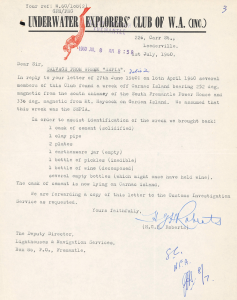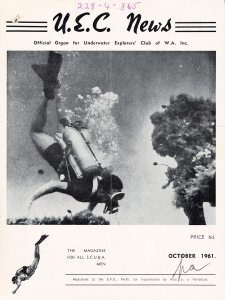Lurking beneath the treacherous waters off Western Australia's coastline, stretching almost 13,000 km in length, are an estimated 1600 sunken vessels. From the 17th century, ships have fallen prey to a coast fraught with natural booby traps – sudden shallow reefs, perilous tides, raging storms and wind-whipping cyclones. Sailors, explorers, fishermen and traders – some escaped with their lives while others went down with the ship. In records held by the National Archives of Australia, these dead men do indeed tell tales.
From London to the locker
On 29 December 1898, with the new year approaching, a three-masted barque met an unfortunate fate 2.9 km offshore between Carnac and Garden Islands. On board were 16 crew and a mixed cargo of 1200 tons, valued at £1200 to £1400.
Built by Denton Grey and Company of Hartlepool and owned by Bethell Gwyn and Company London, the Sepia sailed from London on 14 September 1898 bound for Fremantle. Though Captain Hugh Thomas had been a master for 28 years, he had never sailed to the port of Fremantle before.
On the evening of 29 December 1898, the barque had port in sight. Around 6 pm the order was given to haul up and sail closer to the wind. The vessel then struck a submerged rock at the edge of Five Fathom Bank.
Struggling to escape
With heavy seas breaking over the ship, boats being crushed inward, and cargo beginning to burst through the hatches, the Sepia began to sink.
The master and 11 of the crew were able to disentangle and launch a lifeboat, while 4 of the crew made for the rigging to escape the reach of the sea. In less than 10 minutes, the decks were almost under water. Treacherous waves and flotsam floating around the wreck rendered rescue too dangerous, and so the crew made for Fremantle to summon assistance.
At 9 o'clock that evening, the open boat containing 12 men pulled into the river. The crew were reportedly a sorry spectacle. Only half clothed, most of them were hatless and bootless as they brought news of the disaster.
Orders were given to dispatch the government steamer Penguin to rescue the 4-remaining crew. The Penguin returned early the following morning with the fortunate survivors.
A wreck discovered
The Sepia wreck was discovered by the Underwater Explorer's Club of Western Australia (UECWA) on 16 April 1960. It is now considered to be the most complete iron-hulled vessel in the area containing a well-preserved cargo. The club dived the wreck again and various items were salvaged, including empty wine bottles and bottles of fermented pickles.
Formed in 1954, the UECWA is one of Western Australia's oldest and largest scuba diving clubs and has been involved in the exploration and discovery of many wrecks across the Western Australian coastline. In the 1960s and 1970s, the club's members were integral to early museum expeditions on many Dutch wrecks, including the infamous Batavia, which wrecked on 4 June 1629.
You can discover more about shipwrecks off the Western Australia coastline in records held by National Archives Western Australia Office, The records include correspondence with the Collector and Receiver of Wrecks, newspaper clippings and photographs of discovery and salvage.











